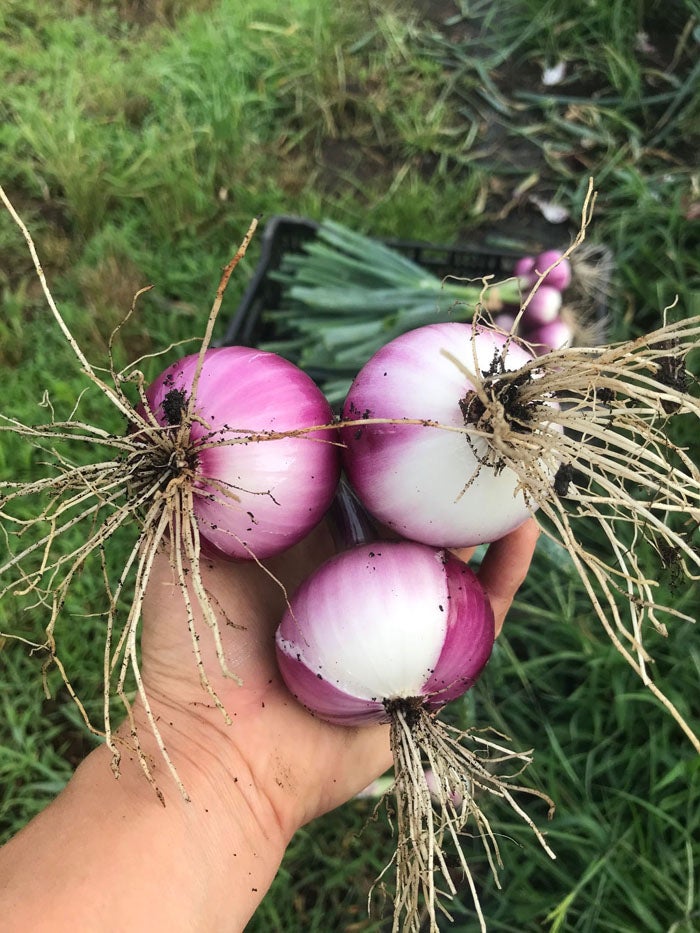Spring fever? Try starting your own onions
Published 12:00 am Sunday, January 10, 2021

- Sweet red onions in June were seeded in January. Submitted photo
By Michael O. Fine
Cooperative Extension
For avid gardeners, winter can be a restless season that seems to go on forever.
For me, winter can sometimes stir up sentiments of and emotions equivalent to a rambunctious child being disciplined with a timeout. Over the past few years, as I have strived to expand my growing season, I have found that January is an excellent time of year to get a jump start on my sweet bulb onions.
Before I realized I could start my own onions from seed, I relied on onion bulbs that were shipped in from southern Texas, where the winter climate is suitable for onions to germinate in the field. The quality of onion starts were fairly reliable, but the price was quite substantial. I began to wonder, “With a little freeze protection, can start my own onion sets?”
The answer was a definite yes. Here are some tips on how this can be accomplished for your own personal onion supply.
• Select an intermediate day onion variety for our Zone (we are Zone 7)
Onions are broken down into three categories: short-day, long-day, and intermediate day. Long-day onions are predominately grown in the northern half of the United States while short-day onions are predominately grown in the deep south. In North Carolina, growers have their best luck with intermediate-day varieties for quality bulb formation and long-term storage.
• Create an environment that is protected from a harsh frost
Onion seeds germinate best in soil temperatures above 60 degrees Fahrenheit. To accomplish this, growers can rig up simple fluorescent shop lights indoors and suspend the lights 4-5” above their seedling trays. An outdoor greenhouse is great during the day-time, but night-time freeze protection will be necessary, especially when the onion seedlings have just sprouted.
• Use a light potting soil labeled as a “germination mix”
Potting soil that is fine-screened for seed germination should not have any large woody chunks and typically is comprised of a high ratio of vermiculite. For small seeds, like those of the onion, the fine textured germinating mix allows for maximum soil contact with each seed. The snug contact between seed and soil helps the emerging seedlings withstand dehydration.
• Supply consistent water to the germinating mix
Watering is always a sensitive aspect to seed germination. Too much water can drown seeds, while supplying too little is a sure means of seedling desiccation. The trick is consistency. The soil should be moist to the touch but should never leave wet residue on your finger-tip when you press on the soil.
• Waiting time
Wait until your onion plants have established roots and your garden soil temperatures reach 50 degrees F. Transplant at 4-6 inches apart.
Typically, I have found that onion starts can be transplanted into the field no earlier than mid-March. Waiting until early April is not a bad idea either, especially if you can keep your young bulbs growing until the field conditions are just right. In the past two seasons, we have found it difficult to differentiate between the bulbs set out late March and those transplanted in mid-April. Space your onion sets with their final size in mind. For most varieties, this means a minimum of 4 inches.
• Fertilize, water and wait until the leaves turn brown and bend over
As with any crop, water and fertilization most be monitored by the grower. Onions need all three of the macro-nutrients (N,P,K) to form healthy foliage and develop a hearty bulb. A soil test is the only way to dial in the exact amount of fertilizer to add to your garden. As for water, 1” of water per week is necessary for optimal growth. Onions cannot thrive in saturated soil, so only water when soil conditions require and make sure your soil drains the excess water away with24 hours.
• Harvest and storage
Typically, by mid-June – early July, the leaves began to dry out and turn brown. Eventually, they will fall over. This is your cue to harvest. Pull the entire plant from the soil and lay your onions out in an area that is well ventilated, dry, and out of the direct sun. Once the leaves are completely dry and crumbly, the bulb has cured. This process usually takes 2-3 weeks. Store your onions in a dry, well ventilated area with minimum light exposure for long-term storage. Most onions can be stored for 2-3 months.
Michael O. Fine is Horticulture and Natural Resource Extension Agent, Rowan County




